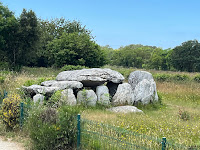 |
| Pont Aven |
As you read this we’ve been back at home for nearly two weeks. Posting was delayed primarily due to our much abbreviated schedule and a bit of illness. To compensate for the less contemporaneous descriptions, we’ve provided a large photo dump. Maybe that will even be preferable.
Photos, lots and lots of photos
Brittany
A longish drive and over 50 euros in tolls brought us to this new region with its distinctive culture. It’s off the beaten path and that’s fine with us. The Celtic influences are still strong here and you’ll frequently see the Breton language - the only Celtic language still widely in use on the European mainland. According to Fodor’s it’s “France’s most fiercely and determinedly ethnic people, . . ..” We visited quite a few small cities and towns never straying far from sea breezes.
La Baule/Vannes
Our Bel Air campground was walking distance to the boardwalk high above the sandy beach with rocky outcroppings. Few braved the cool temperatures and moderate winds to bask seaside but a several sailboats plied the waters and many people strolled or jogged the boardwalk. From here we took a day trip to the walled town of Vannes which emerged from WWII undamaged. We found the port and half-timbered houses in various color schemes endearing in this inviting town. We had a delicious seafood meal at an unassuming restaurant about a block away from camp.
Carnac - The French Stonehenge
We had no idea such a place existed but it’s the largest site of standing stones of this type in the world. The megaliths here were erected during the Neolithic period (between 4500 and 3500 BC). Rows and rows of stones - over 3000, are aligned along this 4 kilometer site and it contains tumulus, dolmens and menhirs. The tumulus and dolmens are funerary edifices but the meaning behind the rows of menhirs hasn’t been determined.The current theory is that the space between the menhirs is important and it may be a sort of story being told. Since the sea level was much lower then, they know that many more stones are hidden under water. They may never unravel the secrets of this mysterious place.
Pont-Aven
Imagine a town so pretty that artists like Paul Gauguin flocked to the place trying to capture the idyllic scenes with canvas, oils and watercolors. The distinctive local garb, thatch-roofed houses, “Bois d’Amour,” picturesque mills and quaint harbor were irresistible. The Musée des Beaux-Arts houses locally-inspired pieces and we spent a nice afternoon there.
Concarneau
Jutting into the harbor is the fortress-islet of Ville Close. The pictures don’t do just it justice because one view can’t set the scene of this medieval town enclosed within walls and surrounded by water. The entry is a drawbridge and the ramparts made for great climbing and views. So fun!
Quimper
Half-timbered houses lean against each other along twisty streets in the old town. Two rivers run through the city and the bridges that link each side are lined with flower planters. The 15th century Cathédrale St.-Corentin has an impressive exterior and that’s flanked by a section of the original city wall. Further downstream is a Roman-era church and medieval garden which was a delight for all the senses.
Douarnenez
Searching the narrow, hilly streets for parking in the campervan was rough but once we found a space slightly less likely to result in damage we strolled into this old fishing town. The tourist map provided directions to quayside paths with great views that led up to “Ferme et gîtes des Plomac’h:” an old farm with small stone cottages typical of those in the 1700’s. A famous writer once resided here and the farm still has a small number of animals.
Trébeurmen
Our campsite was a steep walk down to a pinkish beach with rocky tidal pools surrounded by pink granite cliffs on either side. The sign gives a description of what sea creatures you can bring home for dinner. Our campsite even provided a special sink for washing them up.North of here we took a long hike called Senteniers des Douarnenez from Trestraou beach to St. Guirec beach and back around the oceanfront trail viewing fantastic pink granite rock formations that tumbled down to the ocean and small pink beaches that dotted the coast. Tidal pools supported periwinkles and other mollusks. A beer and cider break at Saint Guirec was just the ticket on this warm day.
St. Malo
If the name seems familiar you’ve probably either read the book or watched the movie “All the Light We Cannot See.” You know we love a good rampart and that’s about all we experienced on this rainy day. Well that, a medieval covered market and a quick stop at an Irish Pub. We happily followed the RS guide which explained the defensive walls. We caught glimpses of the far off Fort La Latte which was used for defense well into the 18th century. Though many city buildings look old, most were built after 1945. About 80% of St. Malo was destroyed in the final days of WWII.
We covered alot of small towns from June 6 to 13!
Next Post: Normandy











No comments:
Post a Comment